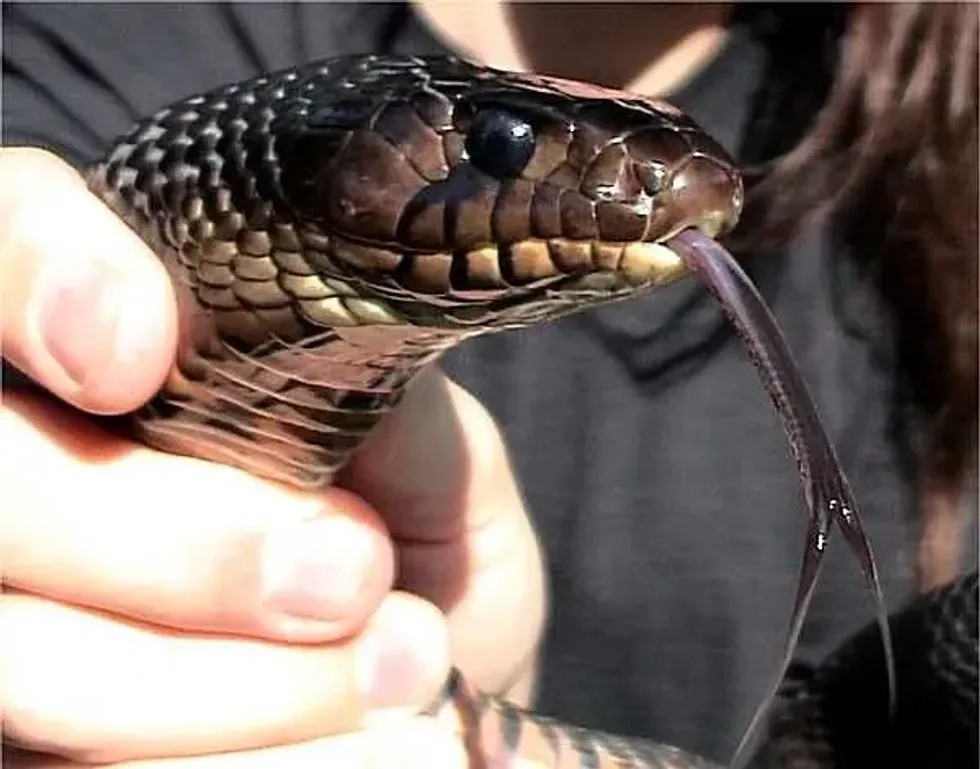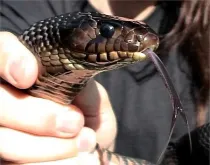The Texas indigo snake (Drymarchon melanurus erebennus) is a threatened species that lives in semi-arid regions. It is considered to be native to the United States (mostly South Texas), though it can be found in Northern Mexico.
They are strong snakes and are non-venomous. Like most snakes, they too lay eggs and generally live in burrows.
Among the indigo snake species, the Texas indigo snake is a famous subspecies. The Texas indigo snake is also known to fight rattlesnakes. When there is a Texas indigo snake vs. rattlesnake, the indigo snake is likely to win!
Hence, this makes this snake species quite an interesting one to read about. If you want to learn more about the Texas indigo snake (Drymarchon melanurus erebennus), then read on.
If you like learning about this snake (Drymarchon melanurus erebennus), you can also read up on the black rat snake and the copperhead snake.
Texas Indigo Snake Interesting Facts
What type of animal is a Texas Indigo Snake indigo snake?
A Texas indigo snake (Drymarchon corais erebennus) is a kind of snake.
What class of animal does a Texas Indigo Snake indigo snake belong to?
The Texas indigo snakes belong to the class Reptilia.
How many Texas Indigo Snakes indigo snakes are there in the world?
Since the Texas indigo snakes have not been studied properly in their wild habitat, there cannot be any specific population number given for them.
Where does a Texas Indigo Snake indigo snake live?
A Texas indigo snake (Drymarchon corais erebennus) prefers a semi-arid environment. It is native to the United States and can be mostly found in Southern southern Texas. They are also found in northern Mexico.
What is a Texas Indigo Snake indigo snake's habitat?
The Texas indigo snake lives in semi-dry areas. They are generally found in savannah grassland regions.
Who do Texas Indigo Snakes indigo snakes live with?
Like most other snakes, the Texas indigo snake is mostly solitary and does not form groups with other snakes.
How long does a Texas Indigo Snake indigo snake live?
While the Texas indigo snake has not been studied properly, it has been estimated that they have a lifespan of about nine 15 years.
How do they reproduce?
Like most snake species, the Texas indigo snake (Drymarchon corais erebennus) is oviparous; that is, they lay eggs. Generally, the breeding process takes place during the winter period. The clutch size of the Texas indigo snake is around 10-12 eggs per clutch. It has been observed that the eggs have an incubation period of around 70-85 days.
What is their conservation status?
The status of Texas indigo snakes has not been evaluated by the IUCN, and hence, it is under the Not Listed Not Evaluated status.
However, according to most wildlife conservationists, the Texas indigo snake is currently under Threatened threatened, as per the Texas state. Since Texas is fast evolving on the industrial front, 95% of the natural habitat of the snake is being destroyed due to urban and industrial development.
However, it is under the protected status, and so it is a crime to kill, or even sell, this snake.
Texas Indigo Snake Fun Facts
What do Texas Indigo Snakes indigo snakes look like?

Texas indigo snakes are large snakes with have a dark brown color with a bluish-black hue due to them being indigo snakes. and mottled They have gray-brown spots over their body. all over them. Since they are indigo snakes, they also carry a bluish-black hue.
How cute are they?
Texas indigo snakes look quite handsome with their bluish-black scales and large body. However, they may not be termed as traditionally cute.
How do they communicate?
Generally, indigo snakes use pheromones to attract females. If a human or predator comes near, then the Texas indigo snake flattens its neck vertically. It also hisses loudly and shakes its tail violently to scare the predator.
How big is a Texas Indigo Snake indigo snake?
The Texas indigo snake stands at a length of 5-8 ft (1.5-2.4 m). However, some researchers have recorded a length of 9 ft 5in 9.4 ft (2.9 m) too. By comparison, the western diamond-backed rattler reaches a maximum length of 7ft 4 in 7.3 ft (2.2 m).
How fast can a Texas Indigo Snake indigo snake move?
The species is understudied, and so it cannot be said how fast a Texas indigo snake can move.
How much does a Texas Indigo Snake indigo snake weigh?
The Texas indigo snake can weigh around 4-5 lb (1.8-2.3 kg).
What are their male and female names of the species?
There are no specific male and female names for snakes.
What would you call a baby Texas Indigo Snake indigo snake?
There are several names that can be given to young snakes. A newly hatched snake is called a hatchling, and a baby is referred to as a snakelet.
What do they eat?
The Texas indigo snake does not seem to be very choosy about its prey. They generally hunt during the daytime (diurnal).
However, they do not often come out in the open and try to live in the abandoned burrows of other animals. They are known to eat a variety of different animals, like toads, baby turtles, mice, and many other small mammals. Young snakes can eat fish too.
Are they poisonous?
Texas indigo snakes are one of the nonvenomous species of snakes in South Texas. However, the Texas indigo snake bite can be quite powerful.
Would they make a good pet?
Many people are known to keep indigo snakes as pets. They are not very harmful and seem relaxed even when a human handles them. They also like to live in abandoned burrows. However, the Texas indigo snake is protected by law and so, keeping them as a pet would be illegal.
Did you know...
The Texas indigo snake is known to kill venomous rattlesnakes. They are also non-aggressive, and so, many Texans feel like these snakes are their ally.
The Texas indigo snake can smear their musk and feces on a predator in an attempt to escape.
Where does the texas Texas indigo snake get its color?
While the Texas indigo snake may look shiny with the smoothened scales, they give out a glossy hue too. Their mottled look is great for hiding them in the savannah grasslands areas that they live in.
How to tell the difference between a Texas indigo and an eastern indigo snake?
The Texas indigo snake is a subspecies of indigo species. Eastern indigo snakes have blue-black scales. On the other hand, the Texas indigo snake may appear black, but they are generally mottled and can have a pinkish underbelly.
Here at Kidadl, we have carefully created lots of interesting family-friendly animal facts for everyone to discover! Learn more about some other reptiles including the coral snake and the kingsnake.
You can even occupy yourself at home by drawing one of our angry snake coloring pages.










